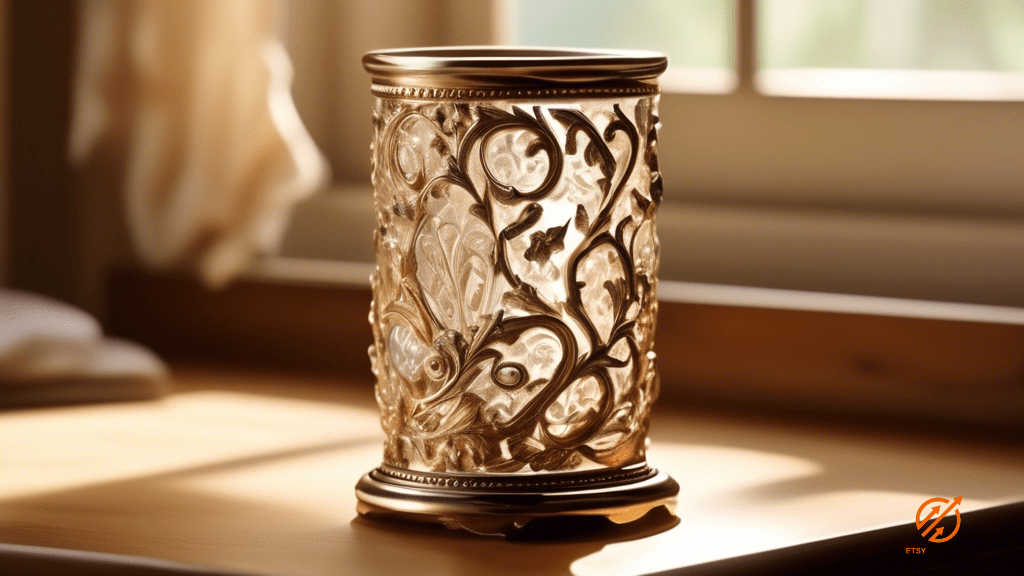Are you a maker of handmade products who often struggles with pricing? If so, you are not alone. Many artisans and crafters find it challenging to determine the right price for their creations.
The good news is that by avoiding common pricing mistakes, you can ensure that you are charging a fair price for your handmade products and maximizing your profits.
In this article, we will guide you through the process of pricing your handmade products effectively. We will discuss the importance of understanding your production costs and researching market prices. By doing so, you can avoid underpricing your products, which can lead to undervaluing your skills and efforts.
Additionally, we will also explore the dangers of overpricing, which can deter potential customers and hurt your sales. Finally, we will provide you with useful pricing strategies that will help you achieve success in the handmade market.
So, let’s dive in and learn how to price your handmade products correctly!
Key Takeaways
- Understanding production costs and conducting market research are essential for effective pricing of handmade products.
- Finding a balance between covering expenses and setting a competitive price is crucial.
- Underpricing can undervalue skills and efforts, while overpricing can deter customers.
- Monitoring the market and adapting prices can optimize revenue and maintain competitiveness.
Understanding Your Production Costs
Now that you have a grasp on the importance of accurately pricing your handmade products, let’s dive into understanding your production costs and how they impact your overall pricing strategy.
When it comes to pricing your handmade products, it’s crucial to have a clear understanding of the costs involved in producing each item. This includes not only the cost of materials but also the expenses related to labor, packaging, and overhead. By accurately calculating your production costs, you can ensure that you’re setting a price that not only covers your expenses but also allows you to make a profit.
To determine your production costs, start by breaking down the cost of materials for each item. Consider the quantity and quality of materials used, as well as any additional costs such as shipping or taxes.
Next, factor in the cost of labor. This includes the time it takes to create each item, as well as any additional labor costs such as hiring help or outsourcing certain tasks. Don’t forget to account for packaging materials and any overhead expenses, such as rent, utilities, and marketing.
By understanding your production costs, you can make informed decisions about pricing your handmade products. It’s important to find a balance between covering your expenses and setting a price that is competitive in the market.
Remember, pricing too low can devalue your products and make it difficult to sustain your business, while pricing too high may deter potential customers. Take the time to analyze your costs and research the market to ensure that your pricing strategy is both profitable and appealing to your target audience.
Researching Market Prices
When researching market prices, it’s important to gather comprehensive data to ensure accurate pricing for your unique creations.
Start by looking at similar products in your niche and analyze their pricing strategies. Take note of the materials used, level of craftsmanship, and any additional features or benefits they offer. This will give you a baseline for what customers are willing to pay for products like yours.
Additionally, consider reaching out to your target audience and conducting surveys or focus groups to understand their perception of value and what they would be willing to pay. This feedback will provide valuable insights into pricing your handmade products competitively.
Furthermore, don’t forget to factor in your own costs and desired profit margin. Calculate the cost of materials, labor, packaging, and any other expenses associated with creating and selling your products. Add your desired profit margin on top of these costs to ensure that you’re not selling yourself short.
By thoroughly researching market prices and gathering comprehensive data, you can confidently set the right price for your handmade products. This will help you avoid underpricing and ensure that you’re earning a fair profit for your hard work and creativity.
Avoiding Underpricing Your Products
To ensure you’re setting the right price for your handmade items, it’s crucial to be mindful of the potential pitfall of underpricing. While it may be tempting to set a lower price in order to attract more customers, underpricing your products can have long-term negative effects on your business.
Here are five reasons why you should avoid underpricing your handmade products:
- You undermine your own value: Setting a low price can give the impression that your products are of lower quality or less valuable than they actually are. Customers may perceive your items as cheap or not worth the price, which can lead to a lack of trust and lower sales.
- It becomes difficult to raise prices: If you start off with a low price, it can be challenging to increase your prices in the future. Customers may become accustomed to the lower price and be resistant to paying more, even if the quality or value of your products has improved.
- You devalue the handmade market: Underpricing not only affects your own business but also the entire handmade market. When handmade products are consistently undervalued, it lowers the perceived worth of handmade items in general, making it harder for other artisans to sell their work at fair prices.
- It’s harder to cover costs and make a profit: Underpricing means you’re not covering the full cost of materials, labor, and other expenses needed to create your products. This can result in financial strain and make it difficult to sustain your business in the long run.
- You limit your growth potential: Setting a low price can limit your ability to invest in your business, improve your products, or expand your reach. Without enough profit margin, it becomes challenging to reinvest in your business and achieve sustainable growth.
By avoiding underpricing, you can ensure that you’re setting a fair price for your handmade products and positioning yourself for long-term success.
Avoiding Overpricing Your Products
Don’t let the temptation of overpricing overshadow the value of your unique handmade creations. While it may be tempting to set high prices for your products in order to maximize your profits, it’s important to strike a balance that reflects the true worth of your items. Overpricing can lead to a decrease in sales and potential customers feeling like they are not getting their money’s worth. To avoid overpricing your products, consider the following factors:
| Factors to Consider | Tips to Avoid Overpricing |
|---|---|
| Cost of Materials | Calculate the cost of materials used to create your product and factor it into the final price. Be sure to include any additional expenses such as packaging and shipping. |
| Time and Effort | Consider the amount of time and effort you put into creating each item. Take into account the intricacy of the design, the skill required, and the time it takes to complete each piece. |
| Market Research | Research the prices of similar handmade products in the market to get a sense of the average price range. This will help you gauge how much customers are willing to pay for items similar to yours. |
By considering these factors and conducting thorough market research, you can set a fair and competitive price for your handmade products. Remember, the goal is to find a balance that allows you to cover your costs, make a profit, and attract customers who appreciate the value of your creations.
Implementing Pricing Strategies for Success
Implementing effective pricing strategies is crucial for achieving success in selling your handmade creations. By carefully considering your pricing approach, you can maximize your profits, attract more customers, and establish your brand as a competitive player in the market.
Here are four key pricing strategies to keep in mind:
- Cost-Plus Pricing: This strategy involves calculating the total cost of producing your handmade products and adding a markup to determine the selling price. By considering direct costs (such as materials and labor) and indirect costs (such as overhead expenses), you can ensure that your prices cover all expenses and generate a reasonable profit.
- Competitive Pricing: Researching and analyzing the prices of similar handmade products in the market can help you set your prices at a competitive level. While it’s important to offer unique and high-quality creations, pricing your products too high compared to your competitors may drive potential customers away. On the other hand, pricing your products too low may devalue your work and lead to lower profits.
- Value-Based Pricing: This strategy involves setting prices based on the perceived value of your handmade products. Consider the unique features, craftsmanship, and the emotional connection that your creations offer to customers. By pricing your products based on the value they provide, you can justify higher prices and attract customers who appreciate the quality and uniqueness of your work.
- Dynamic Pricing: As the market and demand for your handmade products fluctuate, it’s important to be flexible with your pricing. Dynamic pricing involves adjusting your prices in response to changes in supply and demand, seasonal trends, or even special events. By continually monitoring the market and adapting your prices accordingly, you can optimize your revenue and stay competitive in the industry.
Implementing these pricing strategies can help you effectively price your handmade products and increase your chances of success. Experiment with different approaches, monitor customer response, and make adjustments as needed to find the pricing strategy that works best for your business.
Frequently Asked Questions
How can I determine the production costs of my handmade products?
To determine the production costs of your handmade products, you can break it down like a detective solving a case. Investigate the cost of materials, labor, and any additional expenses to get an accurate picture.
What factors should I consider when researching market prices for my handmade products?
When researching market prices for your handmade products, consider factors like the production costs, competitor pricing, target market demand, uniqueness of your product, and perceived value by customers.
How can I ensure that I am not underpricing my handmade products?
To ensure you’re not underpricing your handmade products, research the market to understand what similar items are selling for. Consider the cost of materials, your time, and any additional expenses.
What are some signs that I may be overpricing my handmade products?
Feeling the sting of potential customers passing you by? If your handmade products are gathering dust instead of flying off the shelves, it’s a sign you may be overpricing. Adjust those prices and watch your sales soar!
What pricing strategies can I implement to increase the success of my handmade products?
To increase the success of your handmade products, you can implement pricing strategies such as offering bundle deals, creating limited edition items, providing discounts for loyal customers, and adjusting your prices based on the market demand.
Last Updated: January 22, 2024
Disclosure: We may receive affiliate compensation for some of the links in this article at no additional cost to you if you decide to purchase a product. You can read our affiliate disclosure in our privacy policy.
Kevin Fairbanks is your expert navigator in the world of Etsy business. With a passion for creativity and a deep understanding of the e-commerce landscape, Kevin brings a wealth of knowledge to aspiring and established Etsy sellers alike.
As a seasoned entrepreneur and successful owner of multiple Etsy shops, Kevin knows firsthand the challenges and triumphs of the Etsy marketplace. His journey is one of innovation, perseverance, and a keen eye for market trends, making him an invaluable guide for anyone looking to succeed on Etsy.
Kevin’s expertise extends beyond just shop management; he is adept in areas such as SEO optimization, effective marketing strategies, and financial planning for online businesses. His insights are grounded in real-world experience, offering practical and actionable advice.
Join Kevin as he shares his journey and expertise on Etsy Growth Hub. Whether you’re starting your first Etsy shop or looking to expand your existing business, Kevin’s guidance is designed to help you navigate the complexities of Etsy selling with confidence and creativity.
Stay tuned with Kevin’s latest strategies and tips on Etsy Growth Hub to transform your passion into a thriving online business. His dedication to empowering Etsy sellers is evident in every piece of advice he shares, helping you turn your Etsy dreams into reality.
Verified and Approved by:

Kevin Fairbanks
Head of SEO
Like This Article?
Share with your friends
Table of Contents
Latest Articles
Keep Reading
-
Pricing Strategies For Your Handmade Clothing Line
Learn how to price your handmade clothing line for maximum profits and success in a competitive market. Don’t miss out on these effective pricing strategies – start maximizing your profits today!
-
The Ultimate Inventory Audit Checklist For Accurate Stock Control
Master the art of accurate inventory management with our ultimate inventory audit checklist. Say goodbye to stock discrepancies and take control of your stock with our comprehensive guide. Click here to download now and start improving your inventory control today!
-
Forecasting Sales For Your Etsy Shop
Boost your Etsy shop’s success with expert tips and techniques for accurately forecasting sales. Maximize your profits today and start dominating the market!




